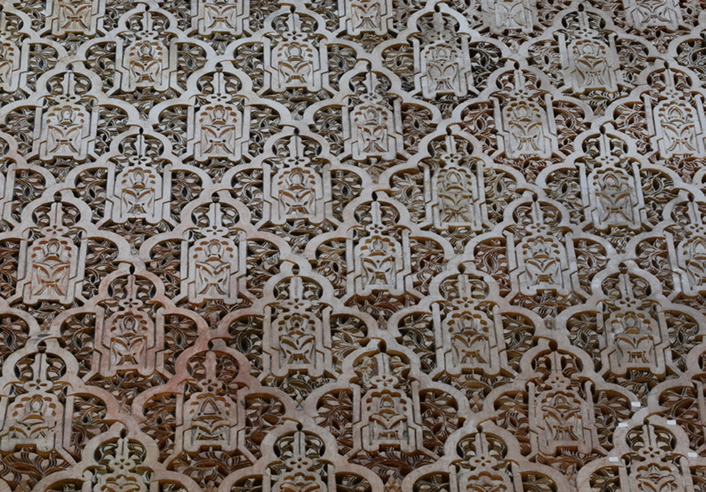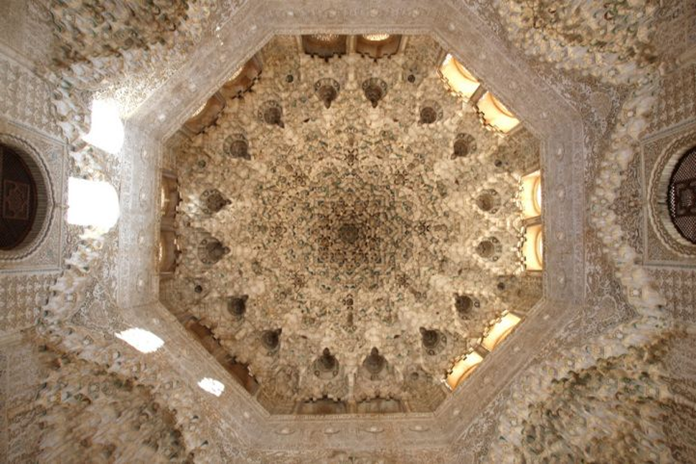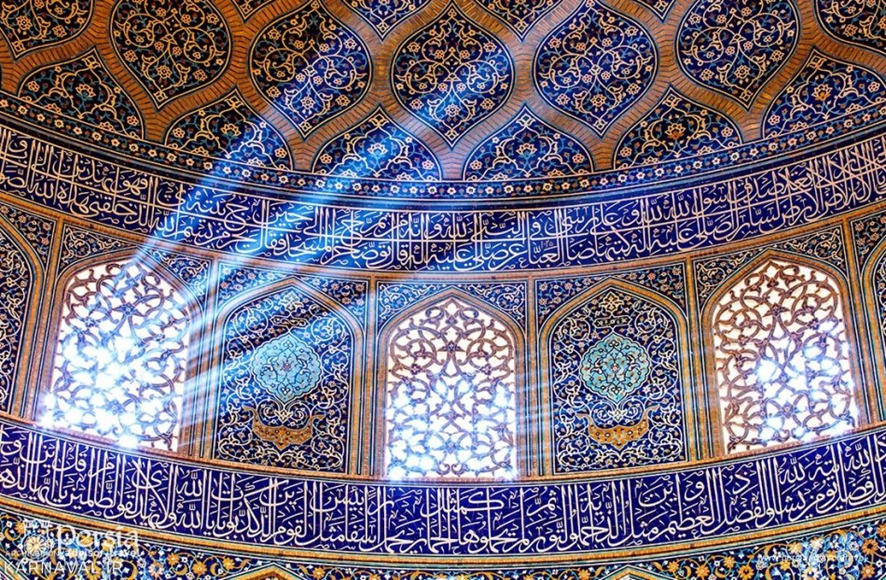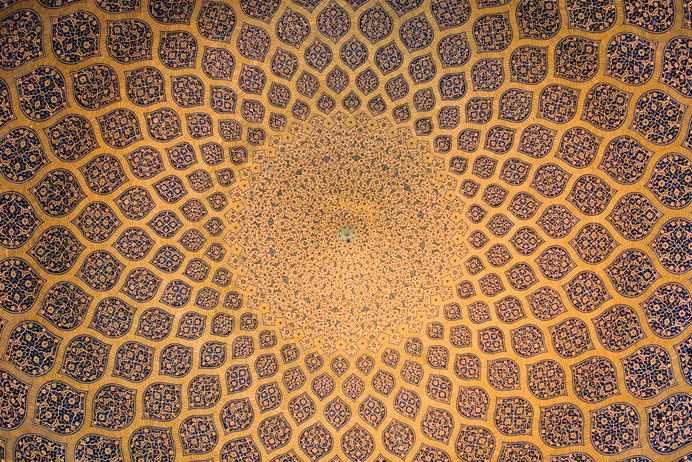Articles
Ibn ‘Arabi and Sufism, a way of reading Islamic architecture
Article author: Cristina de la Peña Pacheco
Date of publication of the article: 26/07/2023
Year of publication: 2023
Article theme: 2023, Architecture, Art, Islam, Religions, Religions.
Why does man choose to express himself through art and how does he do so? What is the true meaning of the artistic forms chosen by Islam? The arts, insofar as they are a powerful tool to shock and delight the senses, are also an important instrument to enliven the spirit and lead it towards divinity. For this reason, most religions and cultures use them as a way of connecting with God.
The case of Islamic art is no exception, even though many Western authors have traditionally studied it from a reductionist perspective, which limits the reason for its forms, compositions and typologies to a simple evolution of style based on techniques borrowed from other cultures adjacent to the limits of its territory.
However, it is easy to see that the forms of Islamic art, especially architecture, have for centuries maintained fixed and immutable characteristics that identify them, and which serve as proof that their purpose is to transmit spiritual values that go beyond the stylistic trends of each time.
The Risale-i Mimariyye, an Ottoman treatise on architecture written by Cafer Efendi in the early 17th century and dedicated to the imperial architect Mehmed Aga, includes a beautiful and evocative quote that alludes to the profound connection between the divine act of creating and the human act of designing:
What is this exalted mosque and retreat for witnessing? What is this lofty vault and lamp ornament? What is this bright window, what is this luminous taper? What is this wonderful creation, and what is this beauteous form? What is this vault of heaven, and what is this surface of the world? What is this lofty arch, and what is this great pavilion? What is this? Who made such an edifice? Without drawings and without mathematics and without analogy?
Sufism, or tasawwuf in Arabic, the spiritual tradition of Islam that develops man’s mystical and esoteric relationship with the world and divinity, understands the meaning of creation as God’s longing to be revealed. Allah creates the universe in order to generate the passage from darkness to light, and everything that makes up the universe therefore contains the divine essence that must be unveiled. Thus, the hadith of the “Hidden Treasure” states: “I (Allah) was a hidden treasure, I wanted to be known, and so I created the universe”.
Testimonies relating to creation, aesthetics and beauty in Islam can be applied to understand this connection between the divine act of creation and the human act of design. For the famous Persian Sufi al-Ghazali, “the visible world was made to correspond to the invisible, and there is nothing in this world that is not a symbol of the other”.
The great 12th century mystic from Murcia, Ibn ‘Arabi, known as Al-Sheikh al-Akbar (“The greatest of the masters”), says in his work Contemplations of the Holy Mysteries:
God made me contemplate the light of intuition and the appearance of the star of transcendence and said to me: within Evidence and intuition I hide myself from whoever is content with veils.
Ibn ‘Arabi and the importance of beauty
Ibn ‘Arabi, who was born in Murcia in 1165 and died in Syria in 1240, is a key figure in the development of the Sufi tradition, and his theoretical and philosophical corpus offers a very special approach to the interpretation of Islamic art, which still has a long way to go. The Iranian researcher Mahsa Rahmani, who has devoted her doctoral thesis to this subject, points out the parallels between Ibn ‘Arabi’s conception of the universe and the ontological meaning of architecture (Rahmani, 2021).
The Sufi author developed a thought of neo-Platonic orientation whose impact was very significant, especially in Eastern Islam and Turkey, although today he remains a fundamental figure within the whole of spiritual thought and Islamic philosophy. However, despite his Murcian origin, he goes unnoticed among the most relevant figures in the Hispanic cultural tradition.
He saw the world as a composition of two parts; one external and visible and the other invisible, conceiving the external, physical world as a reflection of the invisible. God is the invisible world, and is reflected in the visible through His creations. Following Platonic concepts, which determine that love is the primary force that moves the world towards beauty and eternal perfection, Ibn ‘Arabi defined beauty as the cause of all loving force.
God is loved because He is beautiful, and He loves us and all His creations because He loves beauty (Allah Jamil, wa uhibbu el Jamal, God is Beautiful and loves Beauty, says the hadith, or tradition of the Prophet Muhammad). Thus, He is the origin and the end of the cosmos. God’s beauty is the source of all beauty: physical, spiritual, and intellectual, and therefore must be worshipped through all forms of it, including temporal beauty, such as that possessed by the arts. Beauty is powerful and attracts love and desire, and the harmony between humanity and the universe is based on selfless love (‘ishq) (Behrens-Abouseif, 1999).
Truth and Unity
The Prophet Muhammad said in another famous hadith: “He who knows himself, knows his Lord”. Retreat, meditation, study of the Qur’an, or following the fundamental teachings of Islam, are essential acts for approaching God. The believer must engage in a constant practice of that which enables him to know himself, and thus, to unveil the divinity that shapes him and to aspire to the knowledge of God.
Among the tools that Islam develops for this purpose, the immersive experience provided by architecture is fundamental. Divine Truth has no specific form; its essence is infinite and no tangible vessel is capable of containing it. For Sufism, Truth must be sought beyond the limits of superficial existence, for every sensible form (zahir) contains a hidden essence (batin), an inner beauty that must be uncovered (Lomba Fuentes, 2000).
The mystic and jurist of the XII century, Al-Kasani, said:
The sensible knowledge of this world, that is, of the orb of becoming, is the symbol of the intelligible knowledge of this other world. The physical is the symbol and image of the spiritual orb.
However, the moving power of architecture acts as an engine for the search for the hidden Truth; the human capacity to feel, to perceive the movement of his inner self from the contemplation of beauty, is enough to initiate the path of spiritual elevation. Ibn ‘Arabi himself, in his work The Splendour of the Fruits of the Trip, develops this idea of the spiritual journey which, in his words, takes place only within oneself. Drawing on his own experience as an ascetic and physical traveller, as he spent much of his life travelling, he details that the true journey of existence is not made with the feet or the body, but with the soul, with the spirit, while creating “new inner organs of perception”. This journey, moreover, does not have a definitive end, but culminates in the ascent towards becoming Light, where the “absence of absence” is finally contemplated, and serves as a bridge to one’s own essence, where God is the one who marks the crossroads (Ibn ‘Arabi, 2008).
Islamic philosophy, especially that linked to the figure of Ibn ‘Arabi, maintains a clear continuity with Antiquity and especially Late Antiquity. Plotinus’ conception of divinity, which he expresses in his idea of the One, maintains many resonances with the Sufi idea of Unity (Tawhid), since the Murcian philosopher argues that there exists in all reality a kind of constant internal component, a thread that runs through all levels of being, generating this Unity of Existence. It is through the created, through matter, that the mystic can reveal and know the divine presence, which becomes visible in the cosmos, following a method of contemplation, discipline and esoteric interpretation (ta’wil).
The idea of Unity can be clearly seen in Islamic conceptions of artistic production, the intention of which is to make it evident to man by employing the emotive power of the arts. Artistic forms not only generate pleasure, but also stimulate the imagination and the ability to create images in the mind that lead to deep thoughts. Moreover, the abstraction of these forms, when removed from tangible figuration, produces an even more stimulating and evocative effect, as is the case, for example, with music. The reflection of the forms of nature in a pool of rippling water, or the representation of a vegetable garden through its schematization in atauriques, are fully evocative and poetic elements that contribute to the sensitisation of man’s soul more effectively than reality itself.
The role of geometry
In order to better understand this complex thought, it is important to analyse the works of art that best materialise it. One often perceives in Islamic art a transformation of the real into something unreal. The schematization of the forms and objects of reality in its most abstract version reduces to pure geometric forms what, like other cultures, could be imitated in a naturalistic way. However, a mere imitation of the reality of the visible world would not encourage the search for that which goes beyond the limits of the visible.
One of the greatest exponents of the mastery of geometry in Islamic art are the characteristic ataurique decorations that flood the walls of Islamic buildings. The first obvious element of this type of ornamentation is rhythm, perfectly transcribed through geometric meaning. The representations of vegetal elements and stars in the decoration of Islamic art generate a constant visual rhythm of expansion and contraction, a fluidity that is intended to evoke what Sufism considers to be the rhythm of the cosmos. The sense of Unity in Sufism upholds the single origin and end of all things; from Allah one comes and to Allah one returns.
In the words of art historian Titus Burckhardt, Islam is “the religion of the return to the origin, a return that is shown to us as the return of all things to Unity” (Burckhardt, 2016). That origin can be represented in no other way than through geometry, which is the primordial measure by which all visible forms are composed. Abstraction is the most faithful and evocative way to imagine the divine essence that makes up the world.
The ataurique and arabesque patterns recreate the cosmic process of the Creator. Like cycles or waves, they simulate a synchronous succession of time through a rhythmic effect formed from spatial compositions linked together that stand out against a passive background.

The endless succession of these elements extends like cellular divisions, starting from a primary element such as the dot, which composes them and multiplies, turning them into infinity. The innumerable possibilities of combining these forms always create, from very similar patterns throughout the Islamic artistic horizon, almost singular and unique compositions. They are constantly renewed while still expressing a sense of Unity, parallelling what happens in nature but through the abstraction of their forms (Orselli-Dickson, 2017).
The geometric patterns of Islamic art are based on the number one, from which they proliferate, reflecting the action of the Creator. The multiplication of this unity occurs in all directions, following a symmetry and ignoring any limits. One of the clearest examples of this is the decoration of the domes, the muqarnas vaults of the Alhambra in Granada being an exceptional paradigm of it. The ingenuity of the muhandis, or architects, succeeded over time in devising vaults that were increasingly complex and heavy, but more beautiful for their apparent lightness (Ruiz Souza, 2000).
The centre in architecture is a constant reminder of the concept of Divine Unity, and in these constructions one perceives a reproduction of the celestial vision of Islam, where the muqarnas simulate an expansion of the cosmos that proceeds from that centre and multiplies itself.

A beautiful and evocative 15th century Persian poem reads:
The dot appears in the circle, although
was not there…
for this point is the origin of the circle.
The point creates in its turning the circle,
in the eyes of the one who measures it.
Its beginning and its end are united,
when the point measures the totality
of the circle.
When the circle is complete,
the compass joins its feet with its head,
and rests.
All of us are without Self, without Being.
We are without Self, and Thou art the Existent.
He called the whole world His dream; He looked
again and again,
and His dream was Himself.
Sayyid Ni’matullah Wali (s. XV).
Light and colour
In addition to the use of geometric forms, Islamic art seeks the representation of divinity through light and colour. For Sufism, the Pure Light or Absolute Light of divinity is that which brings everything into existence and, in its totality, shines so brightly that the heart of man is not able to perceive it, but it can recognise colours and all that in opposition to darkness becomes visible, says al-Ghazali, for colour manifests itself through light. Thus, colour is a vehicle for the development of the esoteric man, and he perceives it through his “eye of spiritual vision” (‘ayn al-basirah) (Crespo, 2022).
One of the most representative examples of the embodiment of Sufi and mystical theories about light and colour in art is Safavid architecture, essentially because of the strong presence of the development of mysticism in Iranian Islamic culture. The Safavid mystic Lahiji claimed that the shadow world we inhabit is nothingness, while light is the All, and since the All and the world of Absolute Light can only be experienced by a few, it is the job of the creative man to evoke that luminous world through the work of art as its symbol. Illuminated spaces, music, smells, colours and shapes, even tastes; all are evocative and very useful tools for activating the imagination and the senses and directing them towards the exploration of the Self and divinity.

On the other hand, the world of colours is considered a symbol of multiplicity, that capacity for infinite reproduction of Light which, again, would symbolise Absolute Unity. To the symbolism of black and white, associated with the Divine Light and the shadow of the darkness of the world, we can add sandalwood, the colour of the earth, which for the geometrician embodies the neutral plane and for the architect, the ground. Similarly, red is associated with fire and vitality, and is complemented by green, which characterises the superiority of the soul, and also water. Yellow, which symbolises air, contemplation and activity, is complemented by blue, which represents earth, the inferiority of the soul and the end of cycles. The ascending and descending dynamisms of these colours complete a cycle in constant movement.
In Islam, green is the supreme colour because it contains the others: it is the union of blue and yellow, it symbolises hope, the eternal, fertility and its opposite is red. Creative man generates these colours and transforms them into art by participating in alchemy, transmuting matter into a physical and spiritual activity through a conscious choice of colours that leads to the transformation of the soul.
The harmonies, contrasts, brightness and complementarity of colours are an important element of suggestion for the transformative action of art and architecture on the viewer’s interior. Especially as a complement to the decoration of geometric patterns, colour brings a third dimension to forms, a depth that endows them with a beauty capable of totally transforming their perception through tones (Ardalan and Bakhtiar, 2007).
The great mystical component of the act of artistic creation must never be lost sight of, for it is the artist’s eyes that are able to see beyond tangible matter through spiritual vision, and it is his intellect that transmits what he sees to his mind in order to materialise the work of art. That is why his contribution to the world and to the human being is so important, as is the responsibility of the human being to understand and receive his creative contribution correctly.
Through the study and conscious contemplation of geometry, the prominence of the centre, the configuration of the dome, centralised space and the use of light and colour in Islamic architecture, and by applying the ideas of Sufism and such representative authors as Ibn ‘Arabi, one can better understand the spiritual and esoteric foundations that drive the creation of Muslim artists, and spread in the collective idiosyncrasy the idea that Islamic art possesses an immense spiritual depth that must be recognised.
Bibliography
Akkach, Samer, “In the image of the cosmos order and symbolism in traditional islamic architecture. Part 2”, Islamic Quarterly, vol. 38, n. º 2, 1995, pp. 90-106.
Ardalan, Nader, “Color in Safavid Architecture: The Poetic Diffusion of Light”, Iranian Studies, 7, 1974, pp. 164-178.
Ardalan, Nader, Bakhtiar, Laleh, El sentido de la Unidad. La Tradición sufí en la arquitectura persa, Madrid, Siruela, 2007.
Behrens-Abouseif, Doris, Beauty in Arabic Culture, Princeton, Wiener, 1999.
Burckhardt, Titus, El arte del islam. Lenguaje y significado, Palma de Mallorca, Sophia Perennis, 2016.
______, Introducción al sufismo, Barcelona, Paidós, 2006.
Crespo, Ana, “La cualidad develadora de la imaginación: en busca de los tesoros de los colores”, El Azufre Rojo, n. º 10, 2022, pp. 287-305.
Ibn ‘Arabi, El esplendor de los frutos del viaje (trad. Varona Narvión, Carlos), Madrid, Siruela, 2008.
______, El tratado de la Unidad, Barcelona, Ediciones de la Tradición Unánime, 1987.
______, Las Contemplaciones de los Misterios, Murcia, Editora Regional de Murcia, 1994.
Lomba Fuentes, Joaquín, “El papel de la belleza en la tradición islámica”, Anales del Seminario de Historia de la Filosofía, n. º 17, 2000.
Orselli-Dickson, Annalisa, “The geometry of the soul: a sufi view of islamic sacred architecture”, en 1998: Spirit of Place: Source of the Sacred? 1998 Australian International Religion, Literature and the Arts Conference Proceedings, 2017, pp. 275-283.
Rahmani, Mahsa, “Towards an Ontological Understanding of Architecture (Focusing on Mystical Experiences of Ibn Arabi)”, Bagh-e Nazar, vol. 18, n. º 94, 2021, pp. 69-84.
Ruiz Souza, Juan Carlos, “La cúpula de mocárabes y el Palacio de los Leones de la Alhambra”, Anuario Del Departamento De Historia Y Teoría Del Arte, n. º 12, 2000, pp. 9–24.


